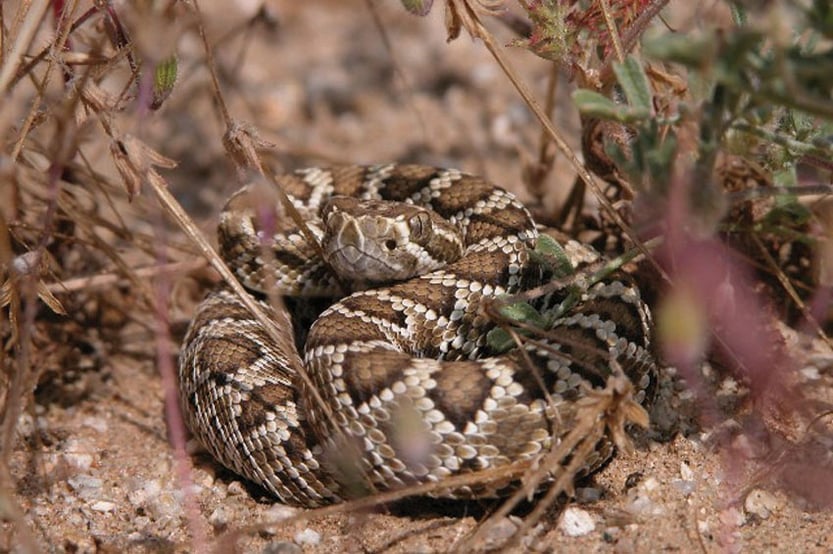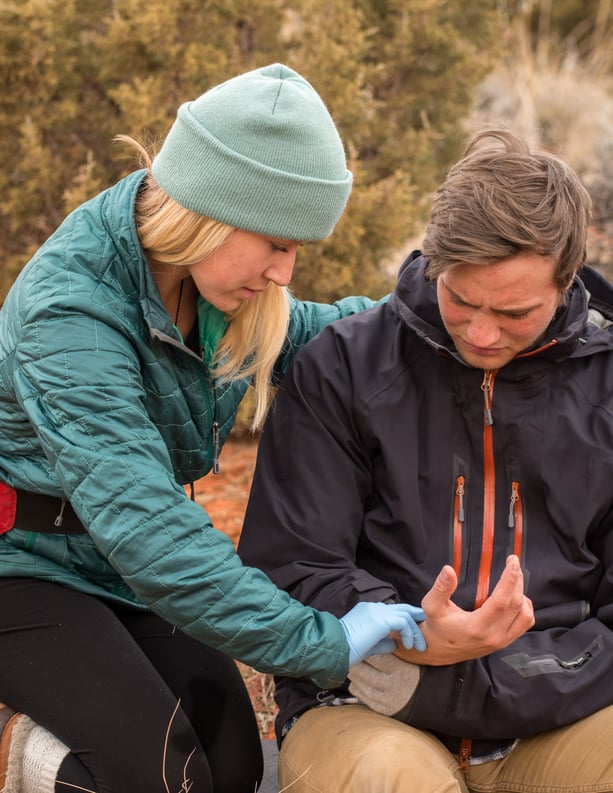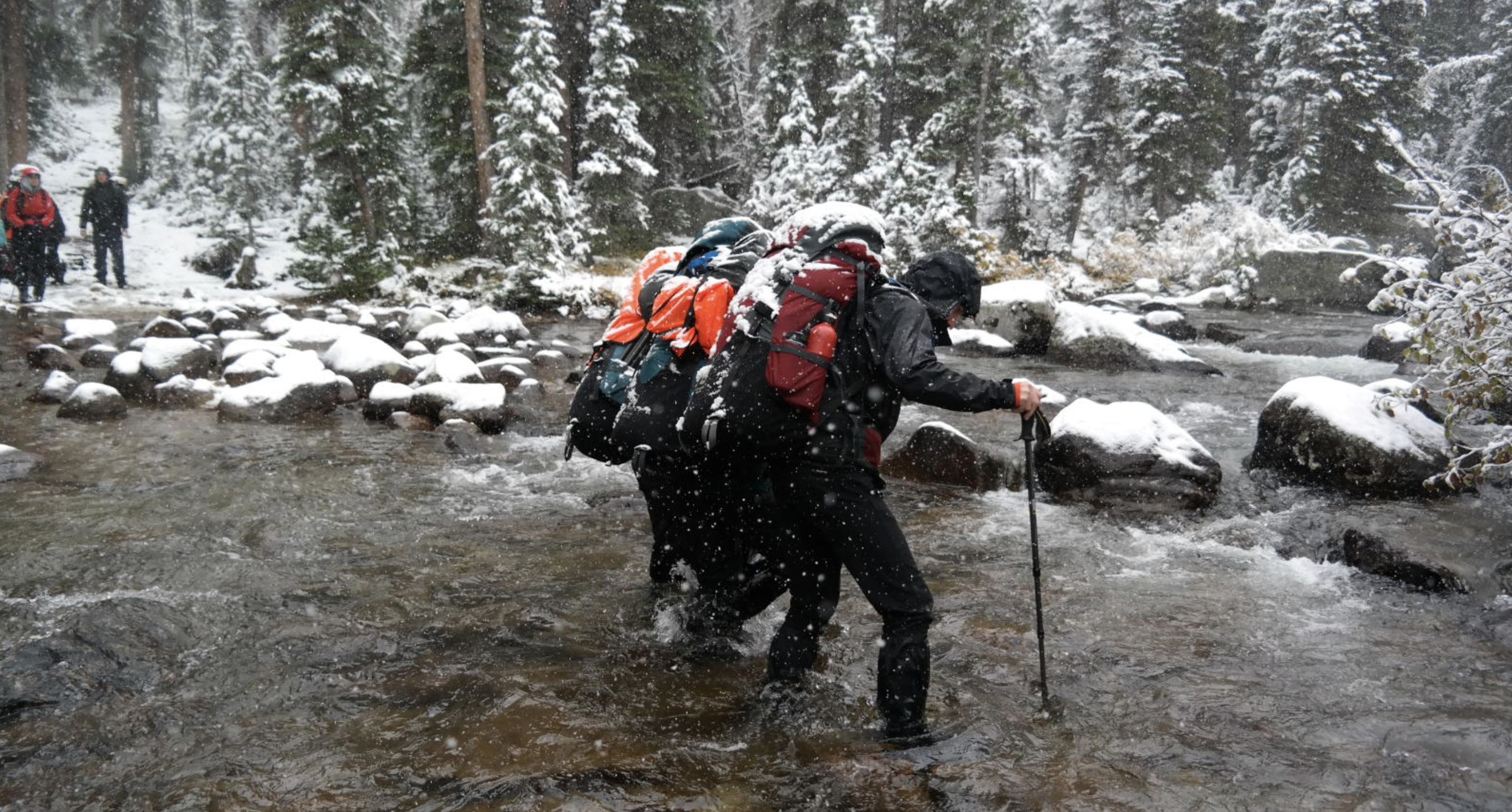The Setting
Editor’s Note: This case study was updated in 2024 to include more information about snakebites.
You are sampling some of the north facing overhanging limestone outside the famed Sinks Canyon climbing area in Wyoming. While walking along the base of the cliff, your partner drops a piece of gear and when they reach to retrieve it you hear a buzzing noise, a cry of surprise, then your partner falls backward.

Photo by Mark Bratton.
A snake with a triangular head and diamond pattern quickly slides around the corner. Your partner is sitting on the ground where they came to a stop. You rush down to them and, as you approach, they say, “It bit me!”
SOAP Report
Subjective
The patient is a 25-year-old female whose chief complaint is a possible snake bite to the right forearm. There is no mechanism for spine injury. The patient is A&O x 4.
Objective
Patient Exam
Patient is sitting and supporting their right forearm. Head-to-toe exam revealed two puncture wounds approximately 3/4” apart on the right forearm. One puncture is weeping clear fluid tinged with blood. Patient complains of persistent ache in right elbow, and states this was present prior to this event. There is no bruising or swelling at the bite site, no tingling or numbness in the arm, and good CSM in the right hand. Patient denies head, neck, and back pain, and did not lose responsiveness. No other injuries were found. CSMs are also normal in the feet and left hand.
Vital Signs
|
Time |
3:40pm |
4:00pm |
|
Level of Responsiveness (LOR) |
A&Ox4, anxious |
A&Ox4, anxious |
|
Heart Rate (HR) |
100, strong and regular |
80, strong and regular |
|
Respiratory Rate (RR) |
22, shallow and regular |
16, shallow and regular |
|
Skin Color, Temperature, Moisture (SCTM) |
pale, cool, clammy |
pink, warm, dry |
|
Blood Pressure (BP) |
strong radial pulse |
strong radial pulse |
|
Pupils |
PERRL (equal, round, responsive to light) |
PERRL |
|
Temperature (T°) |
not taken |
not taken |
History
|
Symptoms: |
Nausea, anxiety |
|
Allergies: |
Penicillin (not taken today). Seasonal allergies, not presently a problem. |
|
Medications: |
Ibuprofen 400mg for elbow pain, taken w/ breakfast, last 2 days. |
|
Pertinent Hx: |
Ache in right elbow for last two weeks. Believed to be climbing overuse injury. |
|
Last in/out: |
Energy bar at 1:00 p.m., 2 liters of water today, bowel movement normal, urine pale yellow |
|
Events: |
None relevant |
Pause here
What is your assessment and plan? Take a few minutes to figure out your own assessment and make a plan. Don’t cheat—no reading on without answering this first!
 Practicing giving patient care. Photo by Jared Steinman
Practicing giving patient care. Photo by Jared Steinman
Assessment
Patient has a probable snakebite on right forearm.
Plan
- Calm the patient.
- Clean the wound.
- Splint and immobilize right arm at the level of the heart.
- Monitor for signs of envenomation.
- Evacuate.
Anticipated problems
- If the patient was envenomated there may be increased pain, bruising and swelling, CSM deficit, or other signs of poisoning by the venom.
Comments
North American native snake envenomations are generally caused by Crotalids (pit vipers: rattlesnakes, water moccasins, copperheads) and far less frequently Elapids (coral snakes).
Signs and Symptoms
Crotalids
- Fang marks.
- Swelling and pain. If absent after 30 minutes, envenomation probably did not occur.
- Bruising and blister formation (over 6-36 hours) and later necrosis.
- Weakness, sweating and chills.
- Nausea and perhaps vomiting.
- Numbness and swollen lymph nodes.
Elapids
- Local swelling.
- Nausea, vomiting.
- Dizziness, weakness, respiratory difficulty (up to 12 hours after bite).
Treatment Principles for Snakebite
These apply worldwide:
- Scene safety: Don't create another victim by attempting to identify, capture or kill a snake.
- Calm yourself and the victim: envenomation is not a given in a snakebite.
- Immobilize the limb: avoid compression/constriction of the extremity.
- Transport to a physician/hospital: the treatment of envenomation is antivenom and supportive care.
- Document the s/s of envenomation to describe the progression to the physician.
- Avoid unproven or discredited treatments that may harm the patient: tourniquets, ice, electricity, meat tenderizer, incision and suction.
These vary by region:
- Wash the wound: Recommended in North America to prevent local wound infection. In Australia, it is not done as it prevents the surface assay to determine the species of snake. In India, it is not recommended because of concern the massage enhances venom distribution.
- Consider pain medications: avoid aspirin due to anticoagulation concerns.
- A wide elastic bandage (pressure immobilization bandage) wrapped distal to proximal as tight as an ankle wrap is recommended for North American coral snake bites and Australian Elapids. In India it is not recommended.
There is misinformation and lore surrounding snakebite first aid. Having the right information about this kind of injury will go far in keeping the patient from further harm.
Many people mistakenly believe a North American pit viper bite is often lethal. In fact, of the 7000-8000 bites reported yearly in the U.S., only 5 or 6 result in death. Death tends to occur in children, the elderly, and those who have delay in antivenom treatment.
Data suggests that envenomation from the pit viper is not automatic every time a snake strikes. Although exact numbers are hard to find, an estimated 30%-50% of reported snake bites are “dry” bites and do not result in envenomation.
Signs and symptoms of envenomation may not present early. Some snakes, such as the coral snake, are known to make you sick 12 or more hours after the bite. Waiting for s/s of envenomation may delay access to antivenom, thus we recommend that all snake bite patients be evacuated, and those with s/s of envenomation be rapidly evacuated.
The Tale Continues
You rinse off the wound and cover it with gauze then place the arm in a sling and swathe and walk five minutes back on the trail to the two-track road. From there you plan to bring your truck to the patient and head towards town.
On the way to the vehicle, you meet a young man with several medical and rescue patches who offers to pull the venom out by applying mechanical suction through a commercially made unit. Citing a recently published peer reviewed article describing the lack of effectiveness of this technique, you politely decline this offer of help and continue on your way. Nor do you accept his offer to cut your patient and draw the venom from the wound with suction applied orally. While you remember John Wayne doing this effectively to Kim Darby in the original movie True Grit (or Jeff Bridges and Hailee Seinfeld in the remake), you know it was only a movie. When you reach your vehicle you find a well-intentioned bystander who offers jumper cables and a car battery to render the venom impotent. This final obstacle between you and your patient’s best interest is calmly avoided.
Comment
When envenomation does occur there are a number of techniques erroneously believed to be effective. Don't perform any unproven or discredited treatments that may cause harm. Some bad treatments keep the venom in the extremity (tourniquet, ice), some try to deactivate the venom (ice, electricity, meat tenderizer, etc) and others try to remove the venom (incision and suction, suction). These techniques have been shown to lack effectiveness when studied in a clinical setting.
What we know to be effective is calming the patient, immobilizing the limb at the level of the heart and, once definitive care is reached, administering antivenom therapy as necessary.
End of the Tale
On the way to the hospital there is a noticeable increase in swelling. Your patient also reports an increase in pain locally, but their vital signs remain stable. By the time the hospital is reached your patient has a tingling sensation throughout the arm and there is bruise-like discoloration surrounding the punctures. The emergency room staff evaluate the patient and give antivenom treatment.
Learn more about treating snakebites on a wilderness medicine course.
FAQs: Snakebite Treatment & First Aid
Types of Snake Bites: What is the difference between venomous snake bites and dry bites?
The difference between a venomous snakebite and a dry bite lies in the presence or absence of venom injection.
Venomous snake bites occur when a venomous snake injects venom into the victim, leading to immediate and intense pain, rapid swelling, bruising, and potentially severe systemic symptoms such as nausea, vomiting, difficulty breathing, sweating, and, in extreme cases, shock or neurological symptoms like blurred vision and muscle paralysis.
In contrast, dry bites happen when a snake bites without injecting venom. These bites might cause mild pain at the site with minimal or no swelling and bruising, and no systemic symptoms.
Visually, both types of bites may show two puncture marks from the snake’s fangs, but the area around a dry bite remains relatively unaffected compared to the pronounced inflammation seen in venomous bites.
Do dry bites occur from nonvenomous snakes or venomous snakes?
Dry bites are specifically from venomous snakes. These occur when a venomous snake bites but does not inject venom. The most venomous snakes, particularly in North America, can cause dry bites, which may happen because the snake may have recently used its venom or may choose not to use it as a defensive measure.
Nonvenomous snakes do not have venom glands, so any bite from them is inherently nonvenomous and cannot be classified as a dry bite.
Therefore, a dry bite indicates a venomous snake that did not release its venom during the bite.
Should a dry bite be taken as seriously as a venomous snake bite?
While dry bites do not involve snake envenomation and generally result in minimal symptoms, they should still be taken seriously and receive proper medical care, just like venomous snakebites. It can be difficult to determine whether a bite is dry or venomous. Initial medical assessment may not be able to rule out the possibility of venom injection, as symptoms of envenomation can sometimes be delayed.
Additionally, even dry bites can lead to infections or allergic reactions. Therefore, seeking medical attention promptly for any snake bite is important to ensure appropriate evaluation and treatment.
NOLS Wilderness Medicine recommends seeking medical care after any animal bite.
How do you determine whether a snakebite is dry or if envenomation has occurred?
After a bite, observing the patient constantly is essential, as some venom effects can be delayed. Dry bites may initially present similarly to venomous bites but will not progress to more severe symptoms.
Continuous monitoring of vital signs and symptoms is crucial. Venomous bites can cause systemic issues such as changes in blood pressure, heart rate, and respiratory function and may include nausea, vomiting, dizziness, difficulty breathing, blurred vision, and muscle weakness or paralysis.
Waiting for signs and symptoms of envenomation can delay access to antivenom treatment.
Therefore, we recommend that all snakebite patients be evacuated immediately and those exhibiting signs of envenomation from snake venom be evacuated urgently.
Once evacuated, seek medical attention so that blood tests may be administered and coagulation parameters may be monitored with proper equipment.
How important is it to know what type of snake caused the bite?
Knowing the type of snake that caused the bite is crucial for several reasons:
- Appropriate Antivenom: Different snakes produce different types of venom, and the treatment for a bite can vary significantly depending on the snake species. In the U.S., it is less necessary to identify the snake, as the same antivenom is given for rattlesnake, copperhead, and water moccasin bites, and coral snake antivenom is no longer available in the U.S. Administering the correct antivenom can be life-saving and reduce the severity of symptoms in countries outside of the U.S. Antivenom is generally administered in the hospital by healthcare providers
- Symptom Management: Understanding the specific venom’s effects allows healthcare providers to anticipate and manage symptoms more effectively. For instance, neurotoxic venom (from cobras or coral snakes) affects the nervous system, while hemotoxic venom (from vipers) affects blood and may have some cytotoxic components that damages tissue. The overwhelming majority of venomous snakes in the U.S. are crotalids, and their toxins are primarily hemotoxic. The one native elapid to the U.S. is the coral snake, which is primarily neurotoxic.
- Risk Assessment: Identifying the snake may help assess the risk of complications and plan the appropriate monitoring and supportive care. Do not attempt to kill or capture the snake, a photo on your phone, from a distance, is sufficient.
- Prevention of Further Incidents: Knowing the species involved can aid in educational and preventive measures in the community.
What are the potential complications of snake envenomation?
Snake envenomation can lead to a range of complications, which can vary depending on the type of snake and the amount of venom injected.
Potential complications include:
- Local Tissue Damage: Swelling, pain, and necrosis at the bite site. Pit vipers, such as rattlesnakes, copperheads, and cottonmouth snakes, are known for causing significant local tissue damage due to their hemotoxic venom.
- Systemic Effects:
- Cardiovascular Issues: Hypotension, shock, and arrhythmias.
Neurological Symptoms: Paralysis, respiratory failure, seizures. - Renal Failure: Acute kidney injury due to hemolysis, myoglobinuria, or direct nephrotoxicity.
- Coagulopathy: Disseminated intravascular coagulation (DIC), bleeding, thrombocytopenia.
- Infection: Secondary bacterial infection at the bite site.
- Compartment Syndrome: Increased pressure within muscle compartments leading to muscle and nerve damage.
- Cardiovascular Issues: Hypotension, shock, and arrhythmias.
- Long-term Effects: Chronic pain, scarring, loss of limb function, and psychological impact.
How long after a snake bite will you show symptoms?
The onset of symptoms after a snake bite can vary widely based on the type of snake, the amount of venom injected, and the individual’s response. Generally:
- Immediate Symptoms: Pain, swelling, and redness at the bite site can occur within minutes to an hour.
- Early Systemic Symptoms: Nausea, vomiting, dizziness, and weakness may appear within the first hour.
- Progressive Symptoms:
- Neurotoxic Venom: Symptoms like blurred vision, difficulty swallowing, and respiratory distress can develop within 30 minutes to several hours.
- Hemotoxic Venom: Symptoms like bleeding, clotting abnormalities, and tissue necrosis may appear within a few hours to a day.
- Sea Snakes: Bites from sea snakes, which belong to the Hydrophidae family, are rare but can be fatal. Fishermen occasionally bitten by sea snakes rarely reach hospitals alive. These are not native to the U.S.
- Delayed Symptoms: Some symptoms, such as renal failure or compartment syndrome, can develop over several hours to days after the bite.
Early medical intervention is critical to manage symptoms and reduce the risk of severe complications.
What should you document about the snakebite for other medical professionals?
- Patient Information: Record the patient’s demographic details and medical history, including any previous incidents of venomous snakebite.
- Details of the Bite:
- Date and time of the bite.
- Description of the snake (if possible).
- Location and condition of the bite site.
- Initial Symptoms & Symptom Progression: Document the onset and progression of symptoms.
- First Aid Provided: Note any first aid measures taken before arrival at the medical facility.
- Clinical Findings: Record vital signs, physical examination findings, and results of laboratory tests.
- Treatment Administered: Document any antivenom or medications given, as well as any other interventions.
What steps should be taken if a snakebite patient's condition worsens during transport?
- Monitor Vital Signs: Continuously monitor the patient’s breathing, heart rate, and level of consciousness, especially in cases of venomous snakebites.
- Maintain Immobilization: Keep the affected limb immobilized and at or below heart level to slow the spread of venom.
- Keep the Patient Calm & Comfortable: Reassure the patient and keep them as comfortable as possible to reduce anxiety and shock.
- Hydration: If the patient is conscious and able to swallow, give them small sips of water to stay hydrated.
- Communicate with Medical Facility: Contact the receiving medical facility to inform them of the patient’s worsening condition and estimated time of arrival.
- Supportive Care: Provide basic supportive care such as:
- Elevating the legs if the patient shows signs of shock (pale, clammy skin, rapid heartbeat).
- Keeping the patient warm with a blanket to prevent hypothermia.
- Applying a clean, dry dressing to the bite area to protect it from infection.
Why is it important to evacuate all snakebite patients?
All snakebite patients should be evacuated for medical assessment regardless of if the bite resulted in obvious envenomation because:
- Symptoms can be delayed or initially mild but may worsen over time.
- Medical professionals need to confirm whether snake venom was injected.
- Prompt treatment can prevent serious complications and improve outcomes.
- Proper wound care can reduce the risk of infection.
How long do snake bites take to heal?
Recovery time varies based on factors such as the type of snake, amount of venom injected, promptness of treatment, and the patient's overall health.
- Immediate Response: Symptoms of a venomous bite often require immediate and ongoing medical care.
- Acute Phase: Initial treatment and stabilization can take days to weeks, depending on the severity.
- Recovery Phase: Healing of the bite site and recovery from systemic effects can take several weeks to months. Severe cases may require longer rehabilitation for tissue damage or complications.
- Long-term Healing: Some patients may experience chronic pain, scarring, or permanent tissue damage, requiring ongoing care and physical therapy.
Written By
Tod Schimelpfenig
As a NOLS Instructor since 1973 and a WEMT, volunteer EMT on ambulance and search and rescue squads since the 70s, Tod Schimelpfenig has extensive experience with wilderness risk management. He has used this valuable experience to conduct safety reviews as well as serve as the NOLS Risk Management Director for eight years, the NOLS Rocky Mountain Director for six years, and three years on the board of directors of the Wilderness Medical Society, where he received the WMS Warren Bowman Award for lifetime contribution to the field of wilderness medicine. Tod is the founder of the Wilderness Risk Manager’s Committee, has spoken at numerous conferences on pre-hospital and wilderness medicine, including the Australian National Conference on Risk Management in Outdoor Recreation, and has taught wilderness medicine around the world. He has written numerous articles on educational program, risk management and wilderness medicine topics, and currently reviews articles for the Journal of Wilderness and Environmental Medicine. Additionally, he is the author of NOLS Wilderness Medicine and co-author of Risk Management for Outdoor Leaders, as well as multiple articles regarding wilderness medicine. Tod is the retired curriculum director for NOLS Wilderness Medicine and is an active wilderness medicine instructor



